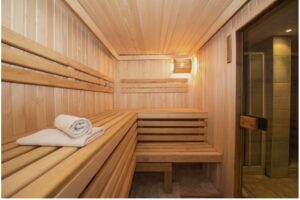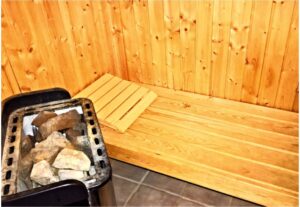A sauna is a small room or building that is designed to create dry heat with a temperature typically ranging from 70-100 degrees Celsius. Saunas are typically made of wood and have heated rocks that create heat, which is then absorbed by the air in the room. While Using a sauna users sit in the sauna and allow their bodies to sweat and detoxify. Saunas are a traditional part of Finnish culture and have become popular worldwide for their potential health benefits.
Using a sauna has several potential benefits for physical and mental health, including:
- Relaxation: Saunas can help relax muscles and reduce stress levels, leading to improved relaxation and feelings of well-being.
- Detoxification: Sweating in a sauna can help release toxins and impurities from the body, leading to improved skin health and overall wellness.
- Improved circulation: The heat from a sauna can increase blood flow and promote better circulation throughout the body.
- Pain relief: Saunas can help reduce pain and inflammation, which can be beneficial for those with chronic conditions such as arthritis.
- Better respiratory function: The heat and steam from a sauna can help clear nasal passages and improve respiratory function for those with asthma or other breathing difficulties.
- Improved athletic performance: Using a sauna can help improve endurance and reduce muscle fatigue, making it beneficial for athletes and fitness enthusiasts.
- Improved immune function: The heat from a sauna can help stimulate the immune system and promote better overall health.
Preparing For the Session
Hydration:
Preventing dehydration, which is a possible risk when using a sauna, is made easier by hydrating before your exercise. It’s crucial to commence your sauna session well-hydrated because when you sweat in the sauna, your body loses water and electrolytes. Before using the sauna, drinking water can help you stay correctly hydrated and can also help you sweat more effectively.
To hydrate before your sauna session, drink at least 8-16 ounces of water or other hydrating beverages, such as coconut water or electrolyte-rich sports drinks, about 30 minutes before entering the sauna. It’s also a good idea to continue to drink water throughout the day to stay hydrated.
Avoid Big Meals:
It’s generally recommended to avoid eating a heavy meal before using the sauna. This is because digesting a large meal requires a lot of energy and can cause your body temperature to rise, which can make you feel uncomfortable or even nauseous in the sauna. Additionally, the heat from the sauna can divert blood flow away from the digestive system, which can slow down the digestion process and make you feel even more uncomfortable.
If you’re planning to use the sauna, it’s best to eat a light meal or snack at least an hour or two before your session. This will give your body time to digest the food before you enter the sauna. It’s also a good idea to avoid alcohol and caffeine before using the sauna, as these can dehydrate your body and make it more difficult to sweat efficiently.
Using the Sauna

Choosing the Right Sauna for You:
Consider your personal tastes as well as any health issues or restrictions you might have when deciding between a traditional sauna, an infrared sauna, and a steam room.
The dry heat produced by traditional saunas, which usually ranges from 160 to 200 degrees Fahrenheit, is produced by heated rocks. In a conventional sauna, the high heat and low humidity can help boost circulation, easing tension in the muscles, and encouraging relaxation. However, people who have breathing problems might find a conventional sauna’s dry heat uncomfortable.
The radiant heat produced by infrared heaters in infrared saunas is immediately absorbed by the body. A normal infrared sauna has heat that is between 120 and 150 degrees Fahrenheit, which is less intense than a traditional sauna but can reach deeper layers of skin and muscles. As a result of the low humidity, infrared saunas are frequently more pleasant for people who have breathing problems.
On the other hand, steam rooms use moist heat and high humidity to produce a warm, soothing atmosphere. A steam room usually has a temperature of 110 to 120 degrees Fahrenheit and a humidity of up to 100%. Steam rooms can help with respiratory health, skin health, stress relief, and muscular tension reduction. The use of a steam room may need to be avoided by people who have certain medical conditions, such as high blood pressure or heart illness.
Starting with Low Temperatures:
If you’re new to using a sauna, it’s important to start with a low temperature and gradually increase it over time. This will allow your body to acclimate to the heat and prevent any discomfort or potential risks associated with sudden temperature changes.
As a general guideline, it’s recommended to start with a temperature of around 70-80 degrees Celsius for your first sauna session. You can then gradually increase the temperature by 5-10 degrees Celsius for subsequent sessions, based on your comfort level.
It’s also important to pay attention to how your body feels during the sauna session. If you start to feel dizzy, lightheaded, or uncomfortable, it’s a sign that the temperature may be too high for you. In this case, it’s important to leave the sauna immediately and cool down.
How Long to Stay in a Sauna:
It is advised to use the sauna for 10 to 30 minutes per session to get the best outcomes with the least amount of potential risk. Your tolerance for heat and personal preferences will determine how long to stay in a sauna, but most health professionals agree that 10 to 30 minutes is a good length of time for most people.
According to research, spending 10 to 30 minutes in the sauna can have a variety of potential health advantages, such as better cardiovascular function, lowered risk of hypertension, enhanced relaxation, and stress relief.
For instance, a study showed that regular use of the sauna for 30 minutes, three times per week, was linked to lower blood pressure levels in those with hypertension. Another study showed that frequent sauna use was linked to a lower risk of cardiovascular disease and overall mortality. It was published in the European Journal of Epidemiology.
Deep Breathing and Relaxation:
Pay careful attention to your deep breathing and relaxation throughout the exercise to get the most out of your sauna experience. In the sauna, your muscles can unwind and endorphins can be produced, which can help with stress reduction and mood improvement.

A key strategy for fostering serenity and peace is deep breathing. Focus on taking slow, deep breaths to help your body relax and release stress. You can also attempt mindfulness or meditation techniques to promote mental clarity and relaxation.
Deep breathing and relaxation techniques have been shown in research to have a variety of possible health advantages, including lowering anxiety, enhancing sleep quality, and improving general well-being.
Cold and Heat Contrast:
A well-liked method to increase the health advantages of using a sauna is to alternate between hot and cold therapies. Following a sauna exercise with a cool shower or plunge into a cold pool can aid in circulation improvement, inflammation reduction, and relaxation.
Your body’s blood vessels enlarge and contract as a result of the contrast between hot and frigid temperatures, which can enhance blood flow and lessen inflammation. This procedure—also referred to as vasodilation and vasoconstriction—can increase the total advantages of your sauna session and hasten your recovery.
According to research, switching between heat and cold therapies can improve a variety of bodily functions, including cardiovascular health, reduce muscle soreness and fatigue, and improve athletic performance.
You can use this technique by directly following your sauna session with a cold shower or a dip in a chilly pool. To further maximize the advantages of cold therapy, you might also think about applying an ice pack or cold compress to sore or inflamed regions of your body.
Post Sauna
Cool Down:
After a sauna session, it’s important to cool down slowly to avoid dizziness or fainting. The sudden change in temperature can cause your blood vessels to dilate rapidly, which can lead to a drop in blood pressure and potential lightheadedness or fainting.
To cool down safely after a sauna session, it’s recommended to first sit or lie down for a few minutes to allow your body to adjust to the cooler temperature. You can also try splashing cold water on your face or taking a cool shower to help regulate your body temperature.
If you start to feel dizzy or lightheaded during the cooling down process, it’s important to stop and rest until you feel better. You can also consider lying down with your feet elevated or using a cold compress on your forehead to help regulate your blood pressure.
Rehydrate with Water and Electrolytes:
It’s important to stay hydrated when using a sauna for the greatest results. When you sweat in the sauna, your body may lose fluids and electrolytes, which could lead to dehydration and other potential health risks.
To prevent dehydration, drink plenty of water before, during, and after your sauna workout. Water is the most important liquid for staying hydrated, even though electrolyte-rich beverages like coconut water or sports drinks can help you replenish the electrolytes lost through sweating.
Minerals called electrolytes help maintain fluid equilibrium in the body as well as normal muscle and nerve function. For maintaining a healthy amount of hydration and preventing dehydration, these nutrients—calcium, magnesium, sodium, and potassium—are essential.
It’s crucial to remember that alcohol and caffeine can have a diuretic impact, which can cause your body to lose even more water. To avoid dehydration, make sure to limit or avoid these drinks before and after your sauna exercise.
Rinse Off:
Taking a cool shower after a sauna session is an important step to rinse off any sweat or toxins that may have accumulated on your skin. Sweat is the body’s natural way of releasing toxins, but it can also leave residue on your skin, which can cause irritation or even infection if left on for too long.
Rinsing off in a cool shower after a sauna session can help to remove this residue, as well as refresh and invigorate your skin. Cool water can also help to regulate your body temperature and prevent any potential overheating or dehydration.
Rest and Recovery:
Resting and allowing your body to recover after a sauna session is a critical step in maximizing the benefits of the experience. The sauna experience can be physically and mentally taxing on your body, and it’s important to give your body time to recover and regenerate.
After a sauna session, it’s recommended to rest for at least 10-15 minutes, preferably in a cool and quiet room. This can help your body to return to its normal resting state and allow your heart rate and blood pressure to normalize.
It’s also important to stay hydrated and replenish any fluids lost through sweating. Be sure to drink plenty of water or other hydrating fluids, and avoid alcohol or caffeine, which can further dehydrate your body.
In addition to physical recovery, the sauna experience can also be mentally and emotionally rejuvenating. Take the time to reflect and relax, meditate, or practice deep breathing exercises to help reduce stress and promote a sense of calm and well-being.
Sauna Safety Considerations

Be Careful if You Have Medical Conditions:
Consulting with your doctor before using a sauna is important if you have any medical conditions or concerns. While using a sauna can have numerous health benefits, it may not be appropriate for everyone, particularly those with certain medical conditions.
Individuals with medical conditions such as heart disease, high blood pressure, diabetes, asthma, epilepsy, or any other chronic health condition should consult with their doctor before using a sauna. Certain medications may also be affected by the heat and humidity of a sauna, so it’s important to discuss any medications you’re taking with your healthcare provider.
Additionally, elderly individuals or those who are prone to fainting or dehydration should take extra precautions when using a sauna and may need to limit their time or avoid using a sauna altogether.
Don’t Use a Sauna If…
To protect people’s well-being, it’s crucial to avoid using a sauna under certain conditions. Due to the possibility of overheating, which can be harmful to both the mother and the growing baby, pregnant women should refrain from using saunas.
Individuals with a history of heart disease, high blood pressure, or other heart conditions should also avoid using a sauna, as the high temperatures and humidity can put extra strain on the heart and cardiovascular system.
If you have any concerns about the safety of using a sauna, or if you have any underlying medical conditions or concerns, it’s important to speak with your healthcare provider before using a sauna. They can help you determine if using a sauna is safe for you, and guide how to use a sauna safely and effectively.
Monitor Your Body’s Response:
Monitoring your body’s response to the heat and leaving the sauna if you feel uncomfortable or experience dizziness or faintness is crucial to ensure your safety when using a sauna.
While sauna use can have numerous health benefits, it can also be physically and mentally taxing on your body, especially if you’re new to using a sauna. It’s important to start slowly and listen to your body as you gradually increase the temperature and length of your sauna sessions.
If at any point you begin to feel uncomfortable, dizzy, or lightheaded, it’s important to exit the sauna immediately and cool down. Drinking water or an electrolyte-rich beverage can help replenish fluids lost through sweating and help regulate your body temperature.
Putting a Towel on This
As previously mentioned, using a sauna properly can have numerous health benefits, including:
- Promoting relaxation and reducing stress
- Improving circulation and cardiovascular function
- Relieving muscle tension and soreness
- Improving skin health and promoting detoxification
- Boosting the immune system
- Supporting weight loss efforts
- Improving respiratory function
Try It For Yourself:
If you’re looking for a natural and relaxing way to improve your health and well-being, I highly encourage you to give sauna therapy a try. Whether you choose a traditional sauna, an infrared sauna, or a steam room, the benefits can be numerous and long-lasting.
If you’re new to sauna therapy, start slowly and listen to your body. Remember to stay hydrated, take breaks as needed, and never push yourself beyond your limits. Always consult with your healthcare provider before using a sauna, especially if you have any underlying medical conditions.
So why not give it a try? Your body and mind will thank you!





What a comprehensive post! Thanks for all of the tips, like avoiding a big meal before getting in the sauna.